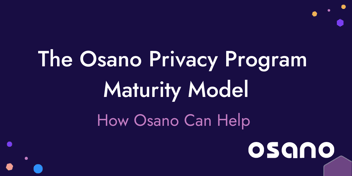
How Osano Can Help
How Osano Can Help You Mature Your Privacy Program Building, running,...
Read NowGet an overview of the simple, all-in-one data privacy platform
Manage consent for data privacy laws in 50+ countries
Streamline and automate the DSAR workflow
Efficiently manage assessment workflows using custom or pre-built templates
Streamline consent, utilize non-cookie data, and enhance customer trust
Automate and visualize data store discovery and classification
Ensure your customers’ data is in good hands
Key Features & Integrations
Discover how Osano supports CPRA compliance
Learn about the CCPA and how Osano can help
Achieve compliance with one of the world’s most comprehensive data privacy laws
Key resources on all things data privacy
Expert insights on all things privacy
Key resources to further your data privacy education
Meet some of the 5,000+ leaders using Osano to transform their privacy programs
A guide to data privacy in the U.S.
What's the latest from Osano?
Data privacy is complex but you're not alone
Join our weekly newsletter with over 35,000 subscribers
Global experts share insights and compelling personal stories about the critical importance of data privacy
Osano CEO, Arlo Gilbert, covers the history of data privacy and how companies can start a privacy program
Upcoming webinars and in-person events designed for privacy professionals
The Osano story
Become an Osanian and help us build the future of privacy!
We’re eager to hear from you
Benchmark and Grow Your Organization’s Privacy Program
Many data subjects are comfortable with businesses that want to use their personal data for one specific, disclosed, and limited purpose. The trouble comes when organizations hold onto their data indefinitely and use it for a multitude of purposes that aren’t disclosed. At the same time, premature deletion of data can hinder operations. A mature privacy program supports the management of personal information (PI) collection, use, and retention in such a way that data is used according to the purpose declared upon its collection. Consent must be secured before PI can be used for any secondary purpose, and PI must be deleted or anonymized when its purpose has been fulfilled.
And of course, prevention is better than cure. Taking steps to minimize data collection can help you in the long term if there is a data breach.
Immature data minimization and purpose limitation practices may involve collecting more data than necessary or using data for purposes outside the original intent. It may be the case that you and other stakeholders lose track of personal data as it moves through and outside of the organization. PI may be transferred to third parties without proper consent or disclosure, even without internal stakeholders’ knowledge.
Mature data minimization and purpose limitation practices involve identifying the minimum amount of personal data required to achieve the intended purpose and ensuring the data is only used for that purpose. This includes regularly reviewing and updating data retention policies, limiting access to personal data, and implementing technical controls such as pseudonymization to protect personal data. Furthermore, any data that is transferred to third parties must be carefully tracked and monitored, and agreements must be in place that limit how third parties can use PI. Your organization will inform data subjects about any transfers, their purpose, and what rights they hold in regard to data transfers.
Before you can optimize your PI collection, use, and retention practices, you’ll need to understand where and how your organization collects and processes personal data. For this reason, a data inventory and/or RoPA should be your first step. Ask yourself why:
Your privacy policy should also be clear about why you collect PI, and your colleagues who work with personal information should understand that they may only use PI for those specific purposes. Work with your IT and operations team members to ensure that only individuals who need to access personal data can access it, and regularly review and update policies and procedures to ensure data is only used for stated purposes unless permitted by the data subject.
With Osano, building, managing, and scaling your privacy program becomes simple. Schedule a demo or try a free 30-day trial today.